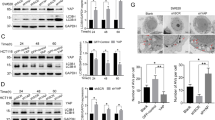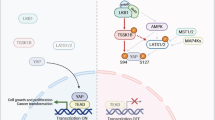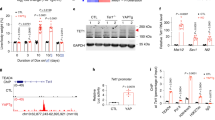Abstract
YES-associated protein (YAP) is a central transcription coactivator that functions as an oncogene in a number of experimental systems. However, under DNA damage, YAP activates pro-apoptotic genes in conjunction with p73. This program switching is mediated by c-Abl (Abelson murine leukemia viral oncogene) via phosphorylation of YAP at the Y357 residue (pY357). YAP as an oncogene coactivates the TEAD (transcriptional enhancer activator domain) family transcription factors. Here we asked whether c-Abl regulates the YAP–TEAD functional module. We found that DNA damage, through c-Abl activation, specifically depressed YAP–TEAD-induced transcription. Remarkably, c-Abl counteracts YAP-induced transformation by interfering with the YAP–TEAD transcriptional program. c-Abl induced TEAD1 phosphorylation, but the YAP–TEAD complex remained unaffected. In contrast, TEAD coactivation was compromised by phosphomimetic YAP Y357E mutation but not Y357F, as demonstrated at the level of reporter genes and endogenous TEAD target genes. Furthermore, YAP Y357E also severely compromised the role of YAP in cell transformation, migration, anchorage-independent growth, and epithelial-to-mesenchymal transition (EMT) in human mammary MCF10A cells. These results suggest that YAP pY357 lost TEAD transcription activation function. Our results demonstrate that YAP pY357 inactivates YAP oncogenic function and establish a role for YAP Y357 phosphorylation in cell-fate decision.
Similar content being viewed by others
Log in or create a free account to read this content
Gain free access to this article, as well as selected content from this journal and more on nature.com
or
Abbreviations
- c-Abl:
-
Abelson murine leukemia viral oncogene
- YAP:
-
YES-associated protein
- TEAD:
-
transcriptional enhancer activator domain
- β-TrCP:
-
β-transducin repeat containing E3 ubiquitin protein ligase
- EMT:
-
epithelial-to-mesenchymal transition
- LATS:
-
large tumor suppressor
- CTGF:
-
connective tissue growth factor
- Cyr61:
-
cysteine-rich angiogenic inducer 61
- MDM2:
-
mouse double minute 2 homolog
- TGF-β:
-
transforming growth factor-β
- NES:
-
nuclear export signal
- PTPN:
-
protein tyrosine phosphatase nonreceptor
References
Harvey K, Tapon N . The Salvador-Warts-Hippo pathway - an emerging tumour-suppressor network. Nat Rev 2007; 7: 182–191.
Pan D . Hippo signaling in organ size control. Genes Dev 2007; 21: 886–897.
Saucedo LJ, Edgar BA . Filling out the Hippo pathway. Nat Rev Mol Cell Biol 2007; 8: 613–621.
Camargo FD, Gokhale S, Johnnidis JB, Fu D, Bell GW, Jaenisch R et al. YAP1 increases organ size and expands undifferentiated progenitor cells. Curr Biol 2007; 17: 2054–2060.
Dong J, Feldmann G, Huang J, Wu S, Zhang N, Comerford SA et al. Elucidation of a universal size-control mechanism in Drosophila and mammals. Cell 2007; 130: 1120–1133.
Zhao B, Wei X, Li W, Udan RS, Yang Q, Kim J et al. Inactivation of YAP oncoprotein by the Hippo pathway is involved in cell contact inhibition and tissue growth control. Genes Dev 2007; 21: 2747–2761.
Sudol M, Harvey KF . Modularity in the Hippo signaling pathway. Trends Biochem Sci 2010; 35: 627–633.
Salah Z, Aqeilan RI . WW domain interactions regulate the Hippo tumor suppressor pathway. Cell Death Dis 2011; 2: e172.
Zhao B, Li L, Tumaneng K, Wang CY, Guan KL . A coordinated phosphorylation by Lats and CK1 regulates YAP stability through SCF(beta-TRCP). Genes Dev 2010; 24: 72–85.
Hao Y, Chun A, Cheung K, Rashidi B, Yang X . Tumor suppressor LATS1 is a negative regulator of oncogene YAP. J Biol Chem 2008; 283: 5496–5509.
Shtivelman E, Lifshitz B, Gale RP, Roe BA, Canaani E . Alternative splicing of RNAs transcribed from the human abl gene and from the bcr-abl fused gene. Cell 1986; 47: 277–284.
Baskaran R, Wood LD, Whitaker LL, Canman CE, Morgan SE, Xu Y et al. Ataxia telangiectasia mutant protein activates c-Abl tyrosine kinase in response to ionizing radiation. Nature 1997; 387: 516–519.
Agami R, Blandino G, Oren M, Shaul Y . Interaction of c-Abl and p73alpha and their collaboration to induce apoptosis. Nature 1999; 399: 809–813.
Yuan ZM, Huang Y, Whang Y, Sawyers C, Weichselbaum R, Kharbanda S et al. Role for c-Abl tyrosine kinase in growth arrest response to DNA damage. Nature 1996; 382: 272–274.
Goldberg Z, Vogt Sionov R, Berger M, Zwang Y, Perets R, Van Etten RA et al. Tyrosine phosphorylation of Mdm2 by c-Abl: implications for p53 regulation. EMBO J 2002; 21: 3715–3727.
Allington TM, Galliher-Beckley AJ, Schiemann WP . Activated Abl kinase inhibits oncogenic transforming growth factor-beta signaling and tumorigenesis in mammary tumors. FASEB J 2009; 23: 4231–4243.
Guo J, Kleeff J, Zhao Y, Li J, Giese T, Esposito I et al. Yes-associated protein (YAP65) in relation to Smad7 expression in human pancreatic ductal adenocarcinoma. Int J Mol Med 2006; 17: 761–767.
Overholtzer M, Zhang J, Smolen GA, Muir B, Li W, Sgroi DC et al. Transforming properties of YAP, a candidate oncogene on the chromosome 11q22 amplicon. Proc Natl Acad Sci USA 2006; 103: 12405–12410.
Zender L, Spector MS, Xue W, Flemming P, Cordon-Cardo C, Silke J et al. Identification and validation of oncogenes in liver cancer using an integrative oncogenomic approach. Cell 2006; 125: 1253–1267.
Kalluri R, Weinberg RA . The basics of epithelial-mesenchymal transition. J Clin Invest 2009; 119: 1420–1428.
Zhao B, Ye X, Yu J, Li L, Li W, Li S et al. TEAD mediates YAP-dependent gene induction and growth control. Genes Dev 2008; 22: 1962–1971.
Zhang H, Pasolli HA, Fuchs E . Yes-associated protein (YAP) transcriptional coactivator functions in balancing growth and differentiation in skin. Proc Natl Acad Sci USA 2011; 108: 2270–2275.
Strano S, Munarriz E, Rossi M, Castagnoli L, Shaul Y, Sacchi A et al. Physical interaction with Yes-associated protein enhances p73 transcriptional activity. J Biol Chem 2001; 276: 15164–15173.
Levy D, Adamovich Y, Reuven N, Shaul Y . Yap1 phosphorylation by c-Abl is a critical step in selective activation of proapoptotic genes in response to DNA damage. Mol Cell 2008; 29: 350–361.
Rosenbluh J, Nijhawan D, Cox AG, Li X, Neal JT, Schafer EJ et al. beta-Catenin-driven cancers require a YAP1 transcriptional complex for survival and tumorigenesis. Cell 2012; 151: 1457–1473.
Levy D, Adamovich Y, Reuven N, Shaul Y . The Yes-associated protein 1 stabilizes p73 by preventing Itch-mediated ubiquitination of p73. Cell Death Differ 2007; 14: 743–751.
Davidson I, Xiao JH, Rosales R, Staub A, Chambon P . The HeLa cell protein TEF-1 binds specifically and cooperatively to two SV40 enhancer motifs of unrelated sequence. Cell 1988; 54: 931–942.
Pluk H, Dorey K, Superti-Furga G . Autoinhibition of c-Abl. Cell 2002; 108: 247–259.
Taagepera S, McDonald D, Loeb JE, Whitaker LL, McElroy AK, Wang JY et al. Nuclear-cytoplasmic shuttling of C-ABL tyrosine kinase. Proc Natl Acad Sci USA 1998; 95: 7457–7462.
Zaidi SK, Sullivan AJ, Medina R, Ito Y, van Wijnen AJ, Stein JL et al. Tyrosine phosphorylation controls Runx2-mediated subnuclear targeting of YAP to repress transcription. EMBO J 2004; 23: 790–799.
Wang MY, Chen PS, Prakash E, Hsu HC, Huang HY, Lin MT et al. Connective tissue growth factor confers drug resistance in breast cancer through concomitant up-regulation of Bcl-xL and cIAP1. Cancer Res 2009; 69: 3482–3491.
Reuven N, Adler J, Meltser V, Shaul Y . The Hippo pathway kinase Lats2 prevents DNA damage-induced apoptosis through inhibition of the tyrosine kinase c-Abl. Cell Death Differ 2013; 20: 1330–1340.
Dupont S, Morsut L, Aragona M, Enzo E, Giulitti S, Cordenonsi M et al. Role of YAP/TAZ in mechanotransduction. Nature 2011; 474: 179–183.
Tumaneng K, Schlegelmilch K, Russell RC, Yimlamai D, Basnet H, Mahadevan N et al. YAP mediates crosstalk between the Hippo and PI(3)K-TOR pathways by suppressing PTEN via miR-29. Nat Cell Biol 2012; 14: 1322–1329.
Varelas X, Miller BW, Sopko R, Song S, Gregorieff A, Fellouse FA et al. The Hippo pathway regulates Wnt/beta-catenin signaling. Dev Cell 2010; 18: 579–591.
Fujii M, Nakanishi H, Toyoda T, Tanaka I, Kondo Y, Osada H et al. Convergent signaling in the regulation of connective tissue growth factor in malignant mesothelioma: TGFbeta signaling and defects in the Hippo signaling cascade. Cell Cycle 2012; 11: 3373–3379.
Poernbacher I, Baumgartner R, Marada SK, Edwards K, Stocker H . Drosophila Pez acts in Hippo signaling to restrict intestinal stem cell proliferation. Curr Biol 2012; 22: 389–396.
Wang W, Huang J, Wang X, Yuan J, Li X, Feng L et al. PTPN14 is required for the density-dependent control of YAP1. Genes Dev 2012; 26: 1959–1971.
Liu X, Yang N, Figel SA, Wilson KE, Morrison CD, Gelman IH et al. PTPN14 interacts with and negatively regulates the oncogenic function of YAP. Oncogene 2013; 32: 1266–1273.
Huang JM, Nagatomo I, Suzuki E, Mizuno T, Kumagai T, Berezov A et al. YAP modifies cancer cell sensitivity to EGFR and survivin inhibitors and is negatively regulated by the non-receptor type protein tyrosine phosphatase 14. Oncogene 2013; 32: 2220–2229.
Michaloglou C, Lehmann W, Martin T, Delaunay C, Hueber A, Barys L et al. The tyrosine phosphatase PTPN14 is a negative regulator of YAP activity. PLoS One 2013; 8: e61916.
Tsutsumi R, Masoudi M, Takahashi A, Fujii Y, Hayashi T, Kikuchi I et al. YAP and TAZ, Hippo signaling targets, act as a rheostat for nuclear SHP2 function. Dev Cell 2013; 26: 658–665.
Wadham C, Gamble JR, Vadas MA, Khew-Goodall Y . Translocation of protein tyrosine phosphatase Pez/PTPD2/PTP36 to the nucleus is associated with induction of cell proliferation. J Cell Sci 2000; 113 (Pt 17): 3117–3123.
Haviv I, Shamay M, Doitsh G, Shaul Y . Hepatitis B virus pX targets TFIIB in transcription coactivation. Mol Cell Biol 1998; 18: 1562–1569.
Morgenstern JP, Land H . Advanced mammalian gene transfer: high titre retroviral vectors with multiple drug selection markers and a complementary helper-free packaging cell line. Nucleic Acids Res 1990; 18: 3587–3596.
Acknowledgements
We thank H Sasaki and KL Guan for the plasmid constructs and G Asher for his assistance in real-time bioluminescence recording. This work was supported by grants from the Israel Science Foundation (Grant No. 551/11) and from the Minerva Foundation with funding from the Federal German Ministry for Education and Research.
Author information
Authors and Affiliations
Corresponding author
Ethics declarations
Competing interests
The authors declare no conflict of interest.
Additional information
Edited by G Melino
Supplementary Information accompanies this paper on Cell Death and Differentiation website
Rights and permissions
About this article
Cite this article
Keshet, R., Adler, J., Ricardo Lax, I. et al. c-Abl antagonizes the YAP oncogenic function. Cell Death Differ 22, 935–945 (2015). https://doi.org/10.1038/cdd.2014.182
Received:
Revised:
Accepted:
Published:
Issue date:
DOI: https://doi.org/10.1038/cdd.2014.182
This article is cited by
-
ABL1 kinase as a tumor suppressor in AML1-ETO and NUP98-PMX1 leukemias
Blood Cancer Journal (2023)
-
Hippo/YAP signaling pathway protects against neomycin-induced hair cell damage in the mouse cochlea
Cellular and Molecular Life Sciences (2022)
-
Riluzole-induced apoptosis in osteosarcoma is mediated through Yes-associated protein upon phosphorylation by c-Abl Kinase
Scientific Reports (2021)
-
Context-dependent roles of YAP/TAZ in stem cell fates and cancer
Cellular and Molecular Life Sciences (2021)
-
Identification of Prolyl isomerase Pin1 as a novel positive regulator of YAP/TAZ in breast cancer cells
Scientific Reports (2019)



